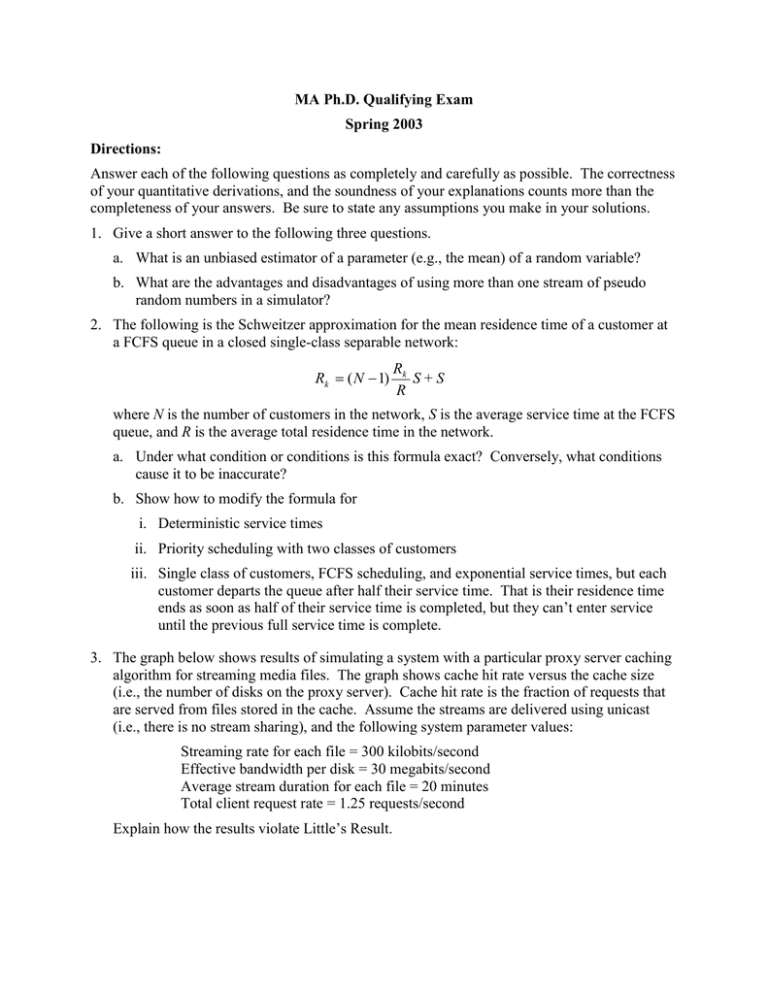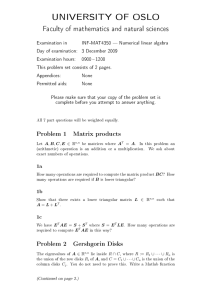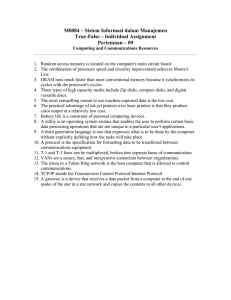ma.doc
advertisement

MA Ph.D. Qualifying Exam Spring 2003 Directions: Answer each of the following questions as completely and carefully as possible. The correctness of your quantitative derivations, and the soundness of your explanations counts more than the completeness of your answers. Be sure to state any assumptions you make in your solutions. 1. Give a short answer to the following three questions. a. What is an unbiased estimator of a parameter (e.g., the mean) of a random variable? b. What are the advantages and disadvantages of using more than one stream of pseudo random numbers in a simulator? 2. The following is the Schweitzer approximation for the mean residence time of a customer at a FCFS queue in a closed single-class separable network: Rk ( N 1) Rk S+S R where N is the number of customers in the network, S is the average service time at the FCFS queue, and R is the average total residence time in the network. a. Under what condition or conditions is this formula exact? Conversely, what conditions cause it to be inaccurate? b. Show how to modify the formula for i. Deterministic service times ii. Priority scheduling with two classes of customers iii. Single class of customers, FCFS scheduling, and exponential service times, but each customer departs the queue after half their service time. That is their residence time ends as soon as half of their service time is completed, but they can’t enter service until the previous full service time is complete. 3. The graph below shows results of simulating a system with a particular proxy server caching algorithm for streaming media files. The graph shows cache hit rate versus the cache size (i.e., the number of disks on the proxy server). Cache hit rate is the fraction of requests that are served from files stored in the cache. Assume the streams are delivered using unicast (i.e., there is no stream sharing), and the following system parameter values: Streaming rate for each file = 300 kilobits/second Effective bandwidth per disk = 30 megabits/second Average stream duration for each file = 20 minutes Total client request rate = 1.25 requests/second Explain how the results violate Little’s Result. 1 Hit Rate 0.8 0.6 Algorithm A 0.4 0.2 0 0 1 2 3 4 5 6 7 8 9 10 Cache Size (Number of Disks) 4. Consider a media server with a number of media files and total client request arrival rate equal to . There are two copies of each file, and each of the two copies is stored on a different disk. There are 4 disks in total, each of which can serve a maximum of C media streams concurrently. Consider the following two allocation strategies to achieve balance in the load on the disks: i. Partition the files into two groups such that the total probability that a request accesses a file in either group is ½. Give each group two disks, and store each file on both disks. ii. Partition the files into six groups such that the total access probability to any of the six groups is 1/6. Group one has copies on disks 1 and 2; group two has copies on disks 1 and 3; etc. for all combinations of two disks. In either case, when a request for a file arrives, pick the least loaded disk among the two disks with copies, to serve it. If both of the disks with copies are already serving C streams, then the request is blocked (i.e., dropped without queueing). (a) Describe how to compute the blocking probability for the first of the above schemes, assuming Poisson arrivals and mean service time equal to T for each file. Explain whether any additional assumptions are required in your solution. (b) Which of the above two schemes would you expect to have better performance, or would you expect them to have the same performance (assuming that perfectly balanced groups are achieved in both cases), and why?



